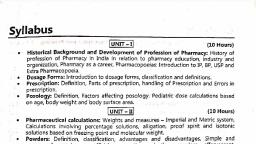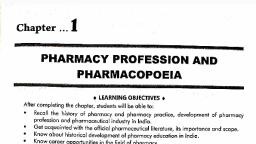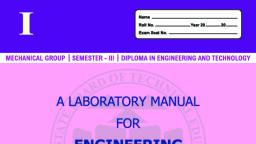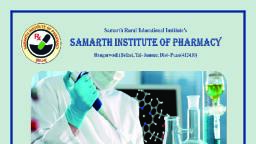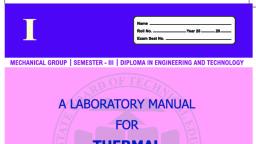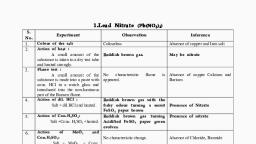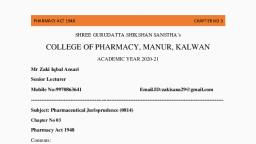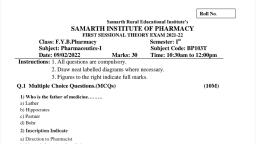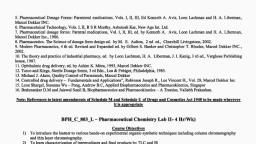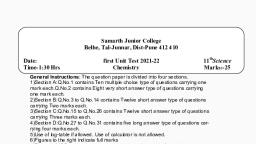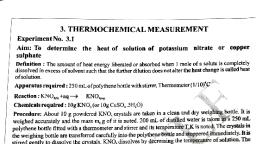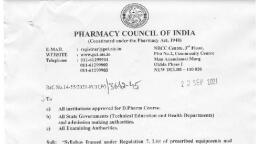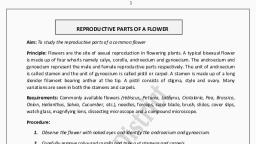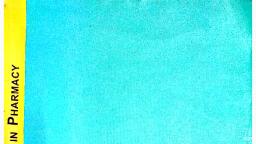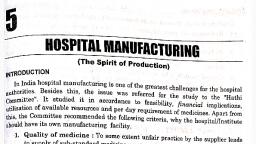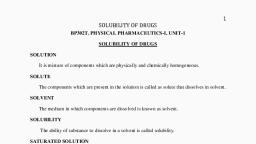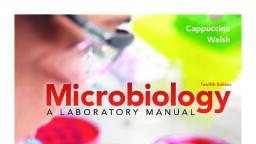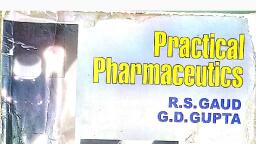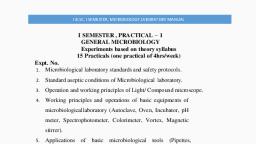Page 1 :
LABORATORY MANUAL FOR, , PHARMACEUTICS I, Name: ........................................................................, Class: First Year Bachelor of Pharmacy., Division: ……………… Batch: ……………………, Roll no: …………………………………………….., Exam Seat No: ……………………………………...
Page 2 :
Samarth Rural Educational Institute’s, , SAMARTH INSTITUTE OF PHARMACY, At-Bangarwadi, Post-Belhe, Tal-Junnar, Dist-Pune, Pin.412410, , Certificate, This is to certify that Mr/Ms...................................................................................., (Exam Seat No...............) has satisfactorily carried out the required practical work,, prescribed by the University of Dr. Babasaheb Ambedkar Technological university, of Lonere, for first/ Second/ Third/ Final year B Pharmacy Course in the Subject, ……………………………………………………………………………, during the academic year 20 - 20, , and this journal represents his/her work with, , in the four walls of this institute., , Date:, , Subject In Charge, , Examiner, , Principal
Page 4 :
INDEX, SR., No., , Title of The Experiments, , Date, , Page, No., , 1, , Introduction to Pharmaceutics-I laboratory, , 1-5, , 2, , To understand concept of Labelling, , 6-10, , 3, , Introduction to Syrups, To prepare and submit Simple Syrup, , 11-13, , To prepare and submit Compound Syrup of, Ferrous Phosphate BPC’68, , 14-16, , Introduction to Elixir, To prepare and submit Piperazine Citrate Elixir, , 17-19, , To prepare and submit Paracetamol Pediatric, Elixir, , 20-22, , 4, , 5, 6, , 7, , 8, , 9, , 10, , Introduction to Linctus, To prepare and submit Terpin Hydrate Linctus, IP’66, To prepare and submit Iodine Throat Paint, (Mandal’s Paint), Introduction to Solutions, To prepare and submit Strong Solution Of, Ammonium Acetate, , 23-25, , 26-28, , 29-31, , To prepare and submit Cresol with Soap, Solution, , 32-34, , 11, , To prepare and submit Lugol’s Solution, , 35-37, , 12, , Introduction to Suspension, To prepare and submit Calamine Lotion, , 38-40, , To prepare and submit Magnesium Hydroxide, Mixture, , 41-43, , 13, , 14, , To prepare and submit Aluminium Hydroxide, Gel, , 44-46, , Marks Signature of, Staff
Page 5 :
INDEX, SR., No., , Title of The Experiments, , Date, , Page, No., , Introduction to Emulsion, To prepare and submit Turpentine Liniment, , 47-52, , To prepare and submit Liquid Paraffin, Emulsion, , 53-55, , 17, , Introduction to Powders and Granules, To prepare and submit ORS Powder (WHO), , 56-62, , 18, , To prepare and submit Effervescent Granules, , 63-65, , 19, , To prepare and submit Dusting Powder, , 66-67, , 20, , To prepare and submit Divided Powder, , 68-70, , 21, , Introduction to Suppositories, To prepare and submit Glycero Gelatin, Suppository, , 71-75, , 15, 16, , 22, , To prepare and submit Coca Butter, Suppository, , 76-77, , 23, , To prepare and submit Zinc Oxide Suppository, , 78-79, , 24, , Introduction to Semisolids, To prepare and submit Sulphur Ointment, , 80-86, , To prepare and submit Non Staining-iodine, Ointment with Methyl Salicylate, , 87-89, , 26, , To prepare and submit Carbopol Gel, , 90-92, , 27, , Introduction to Gargles and Mouthwashes, To prepare and submit Iodine Gargle, , 93-96, , To prepare and submit Chlorhexidine, Mouthwash, , 97-99, , 25, , 28, , Marks, , Signature, of Staff, , Certified that Shri/smt…………………………………………………………………(Seat No………………), of ………….….class has satisfactorily, completed the above term work within the four walls of this institute., , SUBJECT IN CHARGE, , HEAD OF DEPARTMENT
Page 16 :
Pharmaceutics- I (BP109P), , Experiment no. 3, , Experiment No. 3, , 3.0, , 1. Sucrose, 2. Purified water, , 66.7 gm, 100 g, , 4.0, , Category: Vehicle and sweetening agent., Storage: Store in well closed container and keep it in cool place., Direction: Shake well before use., , SAMARTH INSTITUTE OF PHARMACY, BELHE, , 11
Page 17 :
Pharmaceutics- I (BP109P), , Experiment no. 3, , 5.0, , 6.0, , 7.0, , SAMARTH INSTITUTE OF PHARMACY, BELHE, , 12
Page 19 :
Pharmaceutics- I (BP109P), , Experiment no. 4, , Experiment No. 4, To prepare and submit 30 ml of Compound Syrup of Ferrous Phosphate BPC’68., , 2.0, , Principle:, Chemical Food, Ferrish's Food, Ferrish's Syrup are the various synonyms for this preparation., Syrup of Ferrous Phosphate BPC contains iron and electrolytes like calcium, sodium, potassium, which is used as supplement in anemic patients and hence; name is given as chemical food. In, this preparation, phosphoric acid reacts with iron, calcium carbonate, potassium bicarbonate,, and sodium phosphate and results in formation of ferrous acid phosphate, calcium dihydrogen, phosphate, potassium dihydrogen phosphate and sodium dihydrogen phosphate, respectively., Sucrose is sweetening agent, which when dissolved in water, acts as syrup. Sucrose syrup, possesses self-preservative properties. Orange flower water and cochineal is flavouring and, colouring agent, respectively., , 3.0, , Formulation Table:, , 1. Iron, , 0.43 g, , 2. Phosphoric acid, , 4.8 ml, , 3. Calcium carbonate, , 1.36 gm, , 4. Potassium bicarbonate, , 0.100 gm, , 5. Sodium phosphate, , 0.100 gm, , 6. Cochineal, , 0.350 gm, , 7. Sucrose, , 70.0 gm, , 8. Orange-flower water, 9. Purified water q.s., , 5.0 ml, 100.0 ml, , 4.0, 1., 2., , 3., 4., , Dilute half the quantity of phosphoric acid with little amount of water and add iron to it., Gently heat this solution on a water bath until iron gets dissolved., In a separate beaker transfer remaining portion of phosphoric acid and add calcium, carbonate, potassium bicarbonate and sodium phosphate with continuous stirring. At this, step carbon dioxide will be released. Allow carbon dioxide to evolve completely., Mix both the solutions with stirring and allowed to stand for few minutes to complete a, reaction., In a conical flask boil cochineal in water for 15 minutes, cool, strain and pass sufficient water, , SAMARTH INSTITUTE OF PHARMACY, BELHE, , 14
Page 20 :
Pharmaceutics- I (BP109P), , 5., , 6., , Experiment no. 4, , through the strainer. to this add sucrose and again while for 15 minutes to form coloured, syrup., Filter filter iron solution into the coloured syrup. Add Orange flower water and pass, sufficient water through the filter to produce the required volume mix, allow standing for, cooling and filter if necessary., Transfer preparation to narrow mouth Amber coloured glass bottle closed with cap label and, submit., Category: Iron and electrolyte (calcium, potassium and sodium) supplement in anemic patient, Storage: Store in well closed container and keep it in cool and dark place., Direction: Shake well before use., , 5.0, , 6.0, , 7.0, , 1., 2., 3., 4., 5., , What is use of compound syrup of ferrous phosphate BPC 1968., What is General storage condition for syrup., Give some examples of a medicated and flavoured syrup., What is General storage condition for syrup., What is synonym of compound syrup of ferrous phosphate BPC 1968., , SAMARTH INSTITUTE OF PHARMACY, BELHE, , 15
Page 22 :
Pharmaceutics- I (BP109P), , Experiment no. 5, , Experiment No. 5, , To prepare and submit 30 ml of Piperazine Citrate Elixer I.P, , 3.0, , Principle:, Piperazine citrate is freely water soluble anthelmintic agent. To avoid re-infection, it has to be, administered for a period of 8 days. Chloroform spirit, glycerine and orange oil is used as flavouring, agent. Syrup is sweetening agent. Chloroform spirit and glycerine additionally acts as preservative., , 4.0 Formulation Table:, , 1. Piperazine citrate, , 18.0 g, , 2. Chloroform spirit, , 0.5 ml, , 3. Glycerin, , 10.0 ml, , 4. Orange oil, , 0.02 ml, , 5. Syrup, , 50.0 ml, , 6. Purified water, , 100.0 ml, , 5.0, Dissolve Piperazine Citrate in small amount of purified water., 2. Mix Orange oil, glycerine, syrup and chloroform spirit., 3. Add sufficient amount of purified water to produce the final volume., 1., , Category: Anthelmintic., Storage: Store in well closed container., Direction: Shake well before use., , SAMARTH INSTITUTE OF PHARMACY, BELHE, , 17
Page 23 :
Pharmaceutics- I (BP109P), , Experiment no. 5, , 6.0, , 7.0, , 8.0, , SAMARTH INSTITUTE OF PHARMACY, BELHE, , 18
Page 25 :
Pharmaceutics- I (BP109P), , Experiment no. 6, , Experiment No. 6, To prepare and submit 60 ml of Paracetamol Pediatric Elixer I.P, , 2.0, , Principle:, Paracetamol is antipyretic, analgesic drug which possesses poor water solubility. Non-aqueous, solvents due to toxicity cannot be used in higher proportion. Hence; monophasic paracetamol elixir, is prepared by co-solvancy technique. Paracetamol elixir contains alcohol, chloroform spirit,, propylene glycol and glycerol as co-solvents. Invert syrup is sweetening agent. Raspberry juice and, amaranth solution act as flavouring agent and colouring agents, respectively., , 3.0, 4.0 Formulation Table:, , 1. Paracetamol, , 24 g, , 2. Amaranth solution, , 2 ml, , 3. Chloroform spirit, , 20 ml, , 4. Conc. Raspberry juice, , 25 ml, , 5. Alcohol 90%, , 100 ml, , 6. Propylene glycol, , 100 ml, , 7. Invert syrup, , 275 ml, , 8. Glycerol q.s., , 1000 ml, , 5.0, 1. Dissolve paracetamol in a mixture of alcohol, propylene glycol, glycerin, sorbitol solution 70, %, 2. Add sufficient amount of purified water to produce final volume., Category: Antipyretic and analgesic., Storage: Store in well closed container protected from light., Direction: Shake well before use., , SAMARTH INSTITUTE OF PHARMACY, BELHE, , 20
Page 26 :
Pharmaceutics- I (BP109P), , Experiment no. 6, , 6.0, , 7.0, , 8.0, 1., 2., 3., 4., 5., , What are ideal properties if elixir?, Explain two methods of preparation of elixirs., Why dry elixirs are prepared?, Why pediatric elixirs are formulated as flavoured syrups containing little or no alcohol?, Define analgesic and antipyretic., , SAMARTH INSTITUTE OF PHARMACY, BELHE, , 21
Page 28 :
Pharmaceutics- I (BP109P), , Experiment no. 7, , Experiment No. 7, To prepare and submit 20 ml of Terpine Hydrate Linctus I.P, , 2.0, , Prior concepts:, Linctus: Linctuses are viscous monophasic liquids containing high proportion of syrup, which is, intended for treatment of cough., , 3.0, , Principle:, In simple linctus, demulcent and soothing action of syrup is used for relief from cough. Citric acid, and anise water is used as flavouring agent. Amaranth solution is colouring agent. Chloroform spirit, plays an important role in order to maintain stability of formulation against microbial degradation., , 4.0 Formulation Table:, , 1. Terpine hydrate, , 5.0 g, , 2. Glycerine, , 40.0 ml, , 3. Alcohol (30 %), , 40.0 ml, , 4. Syrup, , 10.0 ml, , 5. Orange oil, , 0.02 ml, , 6. Purified water q.s., , 100.0 ml, , 5.0, 1. Weigh exact quantity of terpine hydrate and dissolve in alcohol., 2. Add orange oil, syrup and glycerine to above mixture and mix well., 3. Pour this mixture into a container and adjust volume with water., 4. Submit in well labeled container., Category: Expectorant and Demulcent., Storage: Store in well closed container in cool and dark place., Direction: To be sipped and swallowed slowly without the addition of water., , SAMARTH INSTITUTE OF PHARMACY, BELHE, , 23
Page 29 :
Pharmaceutics- I (BP109P), , Experiment no. 7, , 6.0, , 7.0, , 8.0, 1., 2., 3., 4., 5., , What are ideal properties of elixir?, Explain two methods of preparation of elixirs., Why dry elixirs are prepared?, Why pediatric elixirs are formulated as flavoured syrups containing little or no alcohol?, Define analgesic and antipyretic., , SAMARTH INSTITUTE OF PHARMACY, BELHE, , 24
Page 31 :
Pharmaceutics- I (BP109P), , Experiment no. 8, , Experiment No. 8, To prepare and submit 50 ml of Iodine Throat Paint (Mandal’s Paint), , 2.0, , Prior concepts:, Throat Paints: Throat paints are viscous liquid preparations used for mouth and throat infections., Glycerine is commonly used as a base, being viscous, it adheres to the mucous membrane for a, long time., , 3.0, , Principle:, This preparation is also known as mandal’s paint. Iodine acts as antiseptic agent. It is slightly, soluble in water. It's solubility in water can be increased by addition of complex forming agents, like potassium iodide, as well as by addition of alcohol which acts as co-solvent. Potassium iodide, also possesses expectorant properties. Mentha oil is a flavouring agent. High viscosity of glycerine, increase retention of formulation on affected area. Sweet taste of glycerine helps to increase, patient acceptance., , 4.0 Formulation Table:, , 1. Iodine, , 1.24 g, , 2. Potassium iodide, , 2.48 g, , 3. Water, , 2.48 ml, , 4. Alcohol, , 3.76 ml, , 5. Mentha oil, , 0.40 ml, , 6. Glycerine, , 100.0 ml, , 5.0, 1. Weigh exact quantity of iodine and potassium iodide and dissolve in purified water., 2. Dissolve Mentha oil in alcohol and transfer into iodine solution., 3. Adjust final volume with glycerine., Category: Antiseptic, Storage: Store in well closed container., Direction: Not to be swallowed in large amount., , SAMARTH INSTITUTE OF PHARMACY, BELHE, , 26
Page 32 :
Pharmaceutics- I (BP109P), , Experiment no. 8, , 6.0, , 7.0, , 8.0, , SAMARTH INSTITUTE OF PHARMACY, BELHE, , 27
Page 34 :
Pharmaceutics- I (BP109P), , Experiment no. 9, , Experiment No. 9, To prepare and submit 30 ml of Strong Solution of Ammonium Acetate., , 2.0, , Prior concepts:, Topical solutions are aqueous or non-aqueous preparations applied externally on skin surface., OR, Topical solutions are usually aqueous preparations, but often contain other solvents such as, alcohol, Polyols or Oil, which are intended for topical application to the skin or to the oral mucosal, surface., , 3.0, , Principle:, Strong solution of ammonium acetate is prepared by chemical reaction between glacial acetic acid, and ammonium bicarbonate. Glacial acetic acid reacts with ammonium bicarbonate and results in, formation of blend of ammonium acetate, water and carbon dioxide. This reaction this reaction is, allowed to complete in mortar. Once carbon dioxide gets completely evolved from mortar further, and neutralization is made by addition of strong ammonium solution., Complete neutralization of strong solution of ammonium acetate can be identified by 10 times, dilution of formulation with water and addition of indicators. One drop of bromothymol blue results, in formation of blue colour wild One drop of thymol blue results in formation of yellow colour., , 4.0, , Formulation Table:, , 1. Glacial acetic acid, , 45.3 g, , 2. Ammonium bicarbonate, , 47.0 g, , 3. Strong ammonium, , 10.0 ml, , solution, 4. Water to make, , 100.0 ml, , 5.0, 1., 2., , Dilute glacial acetic acid with 35 ml of water in mortar., Add ammonium bicarbonate in small portion into the mortar. Let the reaction complete,, which is indicated by using of formation of CO2 bubbles., 3. Add strong ammonium solution to above mixture for further neutralization., (Note: Check complete neutralization of the preparation by end point determination as discussed, in the principal if diluted formulation fails to show change in colour after addition of indicator for, SAMARTH INSTITUTE OF PHARMACY, BELHE, , 29
Page 35 :
Pharmaceutics- I (BP109P), , Experiment no. 9, , other added in a quantity of Ammonium solution), , 4., , Adjust the final volume., , Category: Diaphoretic., Storage: Store in lead free glass bottle. Stare in well closed container, in cool place., Direction: Use as directed by physician., , 6.0, , 7.0, , 8.0, 1. Define topical solutions., 2. Write principle of strong solution of ammonium acetate., 3. Write use of glacial acetic acid in this preparation., , SAMARTH INSTITUTE OF PHARMACY, BELHE, , 30
Page 37 :
Pharmaceutics- I (BP109P), , Experiment no. 10, , Experiment No. 10, To prepare and submit 30 ml of Cresol with Soap Solution., , 2.0 PrPrior concepts:, Solubility, volumetric measurement, weight measurement., , 3.0, , Principle:, Cresol is bactericide and germicide. It is caustic in nature. Its harsh effect can be reduced by, presence of vegetable oil. Addition of cresol in water results in formation of turbid solution., Addition of potassium hydroxide or soaps makes formulation clear. Orange oil is used to give, pleasant odour to formulaton., , 4.0, , Formulation Table:, , 1. Cresol, , 50.0 ml, , 2. Vegetable oil, , 18.0 ml, , 3. Potassium hydroxide, , 10.0 ml, , 4. Orange oil, , 4.2 ml, , 5. Water to make, , 100.0 ml, , 5.0, 1. Take weighed quantity of potassium hydroxide in beaker and dissolve in 1/4th volume of, water., 2. Add vegetable oil in beaker and heat on water bath till oil droplets disappear., 3. Dissolve cresol in above mixture and filter., 4. Add orange oil and adjust final volume with water, Category: Bactericide, Germicide, disinfectant., Storage: Store in well closed container, away from direct sunlight., Direction: For external use only., , SAMARTH INSTITUTE OF PHARMACY, BELHE, , 32
Page 38 :
Pharmaceutics- I (BP109P), , Experiment no. 10, , 6.0, , 7.0, , 8.0, , 1., , 2., , SAMARTH INSTITUTE OF PHARMACY, BELHE, , 33
Page 40 :
Pharmaceutics- I (BP109P), , Experiment no. 11, , Experiment No. 11, To prepare and submit 60 ml of Lugol’s Solution (aqueous Iodine solution)., , 2.0, , Principle:, Iodine is wider antiseptic agent which is effective against bacteria, fungi, yeast, protozoa and viruses., It is slightly soluble in water. Its solubility in water can be increased by addition of complex forming, agent like potassium iodide., Beside complexing agent, potassium iodide is an anti-thyroid drug. This solution is also known as, aqueous iodine solution I.P., which is used orally as source of iodine, as well as in treatment of, alkaloid poisoning. Few drops of Lugol’s solution in drinking water is bactericidal and amebicidal., Orally, this solution causes irritation and hence; should be well diluted with water or milk., , 3.0, , Formulation Table:, , 1. Iodine, , 5.0 gm, , 2. Potassium iodide, , 10.0 gm, , 3. Purified water to make, , 100.0 ml, , 4.0, , +, , Category: Antiseptic (Topically), Source of Iodine (Orally)., Storage: Store in well closed container, Direction: i) For external use only. (If prescribed for topical use), ii) Dilute well with water or milk. (If prescribed for oral use), , SAMARTH INSTITUTE OF PHARMACY, BELHE, , 35
Page 41 :
Pharmaceutics- I (BP109P), , Experiment no. 11, , 5.0, , 6.0, , 7.0, , SAMARTH INSTITUTE OF PHARMACY, BELHE, , 36
Page 43 :
Pharmaceutics- I (BP109P), , Experiment no. 12, , Experiment No. 12, To prepare and submit 25 ml of Calamine lotion., , Principle:, , 2.0, , In calamine lotion, both calamine as well as zinc oxide acts as protective and astringent. Bentonite is, suspending agent, while sodium citrate is flocculating agent. Sodium citrate also acts as pH, modifier and antioxidant. Liquid phenol is antipruritic agent. Glycerine is humectant and also helps, to stabilise suspension by increasing viscosity of formulation. Phenol and glycerin together protect, the formulation against microbial degradation., , Formulation Table:, , 3.0, , 1. Calamine, , 15.0 gm, , 2. Zinc Oxide, , 5.0 gm, , 3. Bentonite, , 3.0 gm, , 4. Sodium citrate, , 0.5 gm, , 5. Liquid phenol, , 0.5 gm, , 6. Glycerin, , 5.0 ml, , 7. Rose water q.s., , 100.0 ml, , 4.0, 1., , Pass calamine and zinc oxide from sieve no. 22 and mix together in mortar., , 2. Add bentonite in mortar and mix., 3. Dissolve sodium citrate in 3/4th volume of rose water and add to mortar with trituration., 4. Add liquid phenol in glycerine and triturate with above mixture., 5. Add small quantity of rose water in mortar to make suspension pourable., 6. Transfer this mixture in tared container. Wash mortar with rose water and transfer to container., 7. Adjust final volume with rose water., Category: Protective,, Storage: Store in well closed container., Direction: For external use only., , SAMARTH INSTITUTE OF PHARMACY, BELHE, , 38
Page 44 :
Pharmaceutics- I (BP109P), , Experiment no. 12, , 5.0, , 6.0, , 7.0, 1., 2., 3., 4., 5., 6., 7., 8., , Write the ideal qualities of Lotions., Give classification of liquid dosage forms., Define protective agents, in which parts of world they are generally used., Define sedimentation ratio., Write the procedure for finding rate of sedimentation., Write two brand names of the marketed preparations., What will happen if lotions are stored at temperatures between 20C and 80 C?, Define shelf life; what is generally the shelf life of lotions., , SAMARTH INSTITUTE OF PHARMACY, BELHE, , 39
Page 46 :
Pharmaceutics- I (BP109P), , Experiment no. 13, , Experiment No. 13, To prepare and submit 30 ml Magnesium Hydroxide Mixture (Milk of magnesia)., , 2.0, , Principle:, Cream of magnesia, which is also known as milk of magnesia, can be prepared by two methods,, , 1. Preparation of magnesium hydroxide by precipitation:, MgSO4, +, 2NaOH, Mg(OH)2, +, Na2SO4, Magnesium sulphate Sodium hydroxide, Magnesium hydroxide Sodium sulphate, 2. Preparation of magnesium hydroxide by hydration:, MgO, +, H2O, Mg(OH)2, Light magnesium oxide, Water, Magnesium hydroxide, , 3.0, , Formulation Table:, , 1. Magnesium sulphate, , 4.75 gm, , 2. Magnesium oxide, , 5.25 gm, , 3. Sodium hydroxide, , 1.50 gm, , 4. Chloroform, , 0.25 ml, , 5. Purified water, , 100 ml, , 4.0, 1. Dissolve magnesium sulphate in 25 ml of water in beaker. Let it be mixture A., 2. Dissolve sodium hydroxide in 15 ml of water in another beaker. To it add light magnesium, oxide with continuous stirring, to obtain smooth dispersion. Let it be mixture B., 3. Dilute mixture-B by adding 10 ml of water., 4. Add mixture B in mixture A with continuous stirring., 5. Keep dispersion aside. Separate supernatant liquid from residue., 6. Wash the precipitate with warm water to make it free from sulphate., , 7., SAMARTH INSTITUTE OF PHARMACY, BELHE, , 41, , D
Page 47 :
Pharmaceutics- I (BP109P), , Experiment no. 13, , isperse precipitate in 50 ml water. To it add chloroform water., 8. Adjust final volume with water., Category: Antacid, Laxative., Storage: Store in coloured bottle in cool place., Direction: Shake well before use., , 5.0, , 6.0, , 7.0, 1., 2., 3., 4., 5., , Define mixtures., What is Solution?, What is antacid?, Give application of milk of magnesia., What is the use of magnesium hydroxide?, , SAMARTH INSTITUTE OF PHARMACY, BELHE, , 42
Page 49 :
Pharmaceutics- I (BP109P), , Experiment no. 14, , Experiment No. 14, To prepare and submit 20 gm. of Aluminium Hydroxide Gel., , 2.0, , Principle:, Aluminium hydroxide gel is aqueous suspension of aluminium hydroxide and hydrated, aluminium oxide. It helps to buffer gastric pH between 3 and 4. Aluminium hydroxide gel,, which is also known as antacid suspension, has capacity to neutralize 29.4 mEq of gastric, HCl/g. Sorbitol acts as sweetening agent. Methyl and propyl paraben increases stability of, formulation against microbial degradation. Peppermint oil is flavouring agent, which is, solubilised with the help of alcohol., , 3.0 Formulation Table:, , 1. Ammonium hydroxide gel, , 36.0 gm, , 2. Sorbitol, , 7.0 gm, , 3. Methyl paraben, , 0.2 gm, , 4. Propyl paraben, , 0.2 gm, , 5. Peppermint oil, , 0.005 ml, , 6. Alcohol, 7. Purified water, , 1.0 ml, 100.0 ml, , 4.0, 1. Clean all the glassware and dry them properly as per SOP., 2. Weigh required quantity of aluminium hydroxide gel, sorbitol and transfer to half the portion, of water in mortar and triturate to form smooth dispersion., 3. Add some water and methyl paraben and propyl paraben with continuous stirring., 4. Add peppermint oil dissolved in required quantity of alcohol to above dispersion, 5. Pour formed suspension in measuring cylinder and make-up the volume up to 20 mL, 6. Transfer this suspension to narrow mouth plastic container. Close thoroughly with metallic, screw cap. Label and submit., Category: Antacid., Storage: Store in well closed container in cool place., Direction: Shake well before use., SAMARTH INSTITUTE OF PHARMACY, BELHE, , 44
Page 50 :
Pharmaceutics- I (BP109P), , Experiment no. 14, , 5.0, , 6.0, , 7.0, 1., 2., 3., 4., 5., , Define gels., What is the use of gel?, How gels are applied on skin?, How gels are differ from creams?, What are general application of gel?, , SAMARTH INSTITUTE OF PHARMACY, BELHE, , 45
Page 55 :
Pharmaceutics- I (BP109P), , Experiment no. 15, , Experiment No. 15, To prepare and submit 30 ml of Turpentine liniment., , Principle:, , 2.0, , Turpentine liniment is o/w emulsion produced by bottle method. Soft soap is emulsifying agent., Camphor and turpentine oil act as counter-irritant, as well as rubefacient, which helps in, treatment of muscles and joints pain., , 3.0 Formulation Table:, , 1. Soft soap, , 90 gm., , 2. Camphor, , 50 gm., , 3. Turpentine oil, , 690 ml., , 4. Purified water q.s., , 1000 ml., , 4.0, 1., 2., 3., 4., 5., 6., 7., , It is prepared by bottle method;, Mix soft soap with small portion of water in beaker. Let it be beaker A., In another small beaker, dissolve camphor in turpentine oil. Let it be beaker B., Gradually add content of beaker B in beaker A with constant stirring., Transfer this mixture into bottle., Add water in bottle (around 80% of total volume) and shake to produce milky white emulsion., Keep it aside for 30 minutes., Adjust final volume with water. Shake it again for proper mixing., , Category: Counter irritant and rubeficient., Storage: Store in well closed container away from sunlight., Direction: Shake well before use, For external use onle., , SAMARTH INSTITUTE OF PHARMACY, BELHE, , 50
Page 56 :
Pharmaceutics- I (BP109P), , Experiment no. 15, , 5.0, , 6.0, , 7.0, 1., 2., 3., 4., 5., , Define liniments., What you meant by counter irritant?, How liniments are applied on skin?, What is turpentine oil?, Why liniments are not applied on broken skin?, , SAMARTH INSTITUTE OF PHARMACY, BELHE, , 51
Page 58 :
Pharmaceutics- I (BP109P), , Experiment no. 16, , Experiment No. 16, To prepare and submit 20 ml of Liquid Paraffin Emulsion., , 2.0, , Principle:, It is o/w emulsion prepared by dry gum method. Liquid paraffin is water-insoluble and acts as a, laxative. Indian gum is emulsifying agent. Tragacanth stabilizes emulsion by increasing strength, of interfacial film formed by Indian gum. Sodium benzoate is preservative and vanillin acts as, flavouring agent. Glycerine increases viscosity of formulation and reduces rate of creaming of, emulsion. Chloroform further increases stability by enhancing dispersion of gums., , 3.0 Formulation Table:, , 1. Liquid paraffin, , 50.0 ml, , 2. Indian gum powder, , 12.5 ml, , 3. Tragacanth powder, , 0.5 ml, , 4. Sodium benzoate, , 0.5 gm, , 5. Vanillin, , 0.05 gm, , 6. Glycerin, , 12.5 gm, , 7. Chloroform, , 0.25 ml, , 8. Purified water q.s., , 100.0 ml, , 4.0, 1. Triturate liquid paraffin, chloroform with Indian gum powder and tragacanth. Add vanillin to, above mixture and triturate., 2. Add 1/4"h ml of water to mortar with trituration to produce milky-white primary emulsion., 3. Dissolve sodium benzoate in smallest possible volume of water and add into primary emulsion, with trituration., 4. Add glycerin and mix well., 5. Make above emulsion pourable by further addition of water and trituration., 6. Transfer the mixture into measuring cylinder or tared container and adjust final volume with, water, Category: Laxative., Storage: Store in well closed container away from sunlight., Direction: Shake well before use., SAMARTH INSTITUTE OF PHARMACY, BELHE, , 53
Page 59 :
Pharmaceutics- I (BP109P), , Experiment no. 16, , 5.0, , 6.0, , 7.0, 1., 2., 3., 4., , Define laxative., What is the use of benzoic acid solution and chloroform in liquid paraffin emulsion?, What is emulsion?, What are types of emulsion?, , SAMARTH INSTITUTE OF PHARMACY, BELHE, , 54
Page 61 :
56
Page 62 :
57
Page 63 :
58
Page 64 :
59
Page 65 :
Pharmaceutics- I (BP109P), , Experiment no. 17, , Experiment No. 17, To prepare and submit 10 gm. of ORS (oral rehydration salt) powder (WHO)., , 2.0, , Principle:, ORS formula is choice of treatment to prevent dehydration from diarrhoea. It contains, electrolytes and glucose. Glucose gets absorbed in small intestine and simultaneously, increases absorption of sodium and passive re-absorption of water., World Health Organization (WHO) adopted ORS in 1978, which contains relatively high, proportion of sodium chloride and glucose with total osmotic pressure of 311 mOsm/l. Now,, WHO has released new formula of ORS containing less concentration of sodium chloride and, glucose. Total osmolarity of new formula is 245 mOsm/1., , 3.0 Formulation Table:, , 1. Sodium chloride, , 2.6 gm., , 2. Potassium chloride, , 1.5 gm., , 3. Sodium citrate, , 2.9 gm., , 4. Anhydrous glucose, , 13.5 gm., , 4.0, 1. Weigh all ingredients accurately and pass through sieve no. 60, 2. Mix all ingredients together by spatulation method, which involves mixing of powders by, movement of spatula through the mixture, on paper or tile., Category: Fluid and electrolyte replacer., Storage: Packed in air tight sachets or in screw capped bottle., Direction: Use within 24 hours after reconstitution., , SAMARTH INSTITUTE OF PHARMACY, BELHE, , 60
Page 66 :
Pharmaceutics- I (BP109P), , Experiment no. 17, , 5.0, , 6.0, , 7.0, 1., 2., 3., 4., , Define Powders., What are advantages of solid dosage form over other dosage form?, What are different types of pharmaceutical powders?, Which are the different method of preperation of powders?, , SAMARTH INSTITUTE OF PHARMACY, BELHE, , 61
Page 68 :
Pharmaceutics- I (BP109P), , Experiment no. 18, , Experiment No. 18, To prepare and submit 10 gm. Of Effervescent granules., , 2.0, , Principle:, , Sodium sulphate is a laxative. Mixture of citric acid, tartaric acid, sodium bicarbonate acts as, effervescent salt., , 3.0 Formulation Table:, , 1. Sodium sulphate, , 50.0 gm., , 2. Citric acid, , 21.0 gm., , 3. Tartaric acid, , 24.0 gm., , 4. Sodium bicarbonate, , 50.0 gm., , 4.0, 1. Weigh all material (15% extra) and pass from sieve no. 60., 2. Mix all powders together by spatulation method., 3. Transfer this mixture to a hot porcelain plate, which is kept on water bath., 4. Prepare coherent mass of material by continuous heating and pressing the powder material, with spatula., 5. Pass the cohesive mass through the sieve to obtained granules of desired size., Category: Antacid and Carminative., Storage: Store in well closed container in dry place., Direction: Add two spoonful of granules to a glass of water with stirring and drink the solution, while effervescing., , SAMARTH INSTITUTE OF PHARMACY, BELHE, , 63
Page 69 :
Pharmaceutics- I (BP109P), , Experiment no. 18, , 5.0, , 6.0, , 7.0, 1., 2., 3., 4., 5., , Define Carminative., Define Antacid., Which are different methods of granulation?, Which are different excipients used for preparation of granules?, What is common storage condition for powders and granules?, , SAMARTH INSTITUTE OF PHARMACY, BELHE, , 64
Page 71 :
Pharmaceutics- I (BP109P), , Experiment no. 19, , Experiment No. 19, To prepare and submit 10 gm. Of Dusting Powder., , 2.0, , Principle:, It is medicated powder in which zinc oxide acts as astringent and starch powder as adsorbent., , 3.0 Formulation Table:, , 1. Zinc oxide, , 25.0 gm., , 2. Starch powder, , 25.0 gm., , 4.0, 1. Weigh both ingredients accurately and pass through sieve no. 85., 2. Mix them by trituration method., 3. Transfer in container and submit., Category: Astringent and Antiseptic., Storage: Store in well closed container in cool place., Direction: For external use only., , 5.0, , SAMARTH INSTITUTE OF PHARMACY, BELHE, , 66
Page 72 :
Pharmaceutics- I (BP109P), , Experiment no. 19, , 6.0, , 7.0, 1., 2., 3., 4., , Define astringents., Define antiseptics., Give application of dusting powder., Write the use of starch powder in dusting powder., , SAMARTH INSTITUTE OF PHARMACY, BELHE, , 67
Page 73 :
Pharmaceutics- I (BP109P), , Experiment no. 20, , Experiment No. 20, To prepare and submit 10 gm. Of Divided Powder., , Principle:, , 2.0, , Potent drugs, where dose accuracy is very important, are dispensed in the form of divided, powder. If dose is less than 120 mg, certain diluents are added to adjust the weight. In this, preparation, aspirin and paracetamol is used as analgesic and antipyretic, which belongs to, class of NSAID's, i.e. non-steroidal anti-inflammatory drugs. As weight of each pack is 500 mg;, there is no need to add any diluents., , 3.0 Formulation Table:, , 1. Aspirin, , 300 mg, , 2. Paracetamol, , 150 mg, , 4.0, 1., 2., 3., 4., 5., , Weigh the calculated amount of aspirin and paracetamol., Mix them thoroughly., Weigh 450 mg of mixed powder., Divide the powder in four equal parts., Wrap in suitable size powder papers., Category: Analgesic and antipyretic., Storage: Store in well closed container in cool place., Direction: As directed by physician., , SAMARTH INSTITUTE OF PHARMACY, BELHE, , 68
Page 74 :
Pharmaceutics- I (BP109P), , Experiment no. 20, , 5.0, , 6.0, , 7.0, 1., 2., 3., 4., 5., , What are diveded powders?, Define analgesics., Define antipyretics., What are potent drugs?, What are tablet triturates?, , SAMARTH INSTITUTE OF PHARMACY, BELHE, , 69
Page 76 :
71
Page 78 :
Pharmaceutics- I (BP109P), , Experiment no. 21, , Experiment No. 21, To prepare and submit Glycero Gelatin Suppository., , 2.0, , Formulation Table:, , 1. Gelatin, , 50.0 gm, , 2. Glycerol, , 21.0 gm, , 3. Water q.s., , 100.0 gm, , 3.0, 1. Soak gelatin in purified water for about five minutes or until thoroughly softened, and then, drain well. Add Glycerin and heat on water bath. Evaporate excess quantity until the mixture, weighs 100 g. Pour the product into suitable mould., Category: Rectal evacuants., Storage: Pack individual wrapped suppository in to wide mouth container, in cool place., Direction: For rectal use only., , 4.0, , SAMARTH INSTITUTE OF PHARMACY, BELHE, , 73
Page 79 :
Pharmaceutics- I (BP109P), , Experiment no. 21, , 5.0, , 6.0, 1., 2., 3., 4., 5., , What are Suppositories?, Define Rectal evacuants., What are vaious types of bases?, What are pessaries?, What is glecerol suppository?, , SAMARTH INSTITUTE OF PHARMACY, BELHE, , 74
Page 81 :
Pharmaceutics- I (BP109P), , Experiment no. 22, , Experiment No. 22, To prepare and submit Coca Butter Suppository., , 2.0, , Principle:, Boric acid suppository is used as antiseptic and anti-infective. Boric acid is insoluble in cocoa, butter and hence; it is dispersed in molten mass of base. Cocoa butter is also known as, theobroma oil obtained from roasted seeds of Theobroma cacao, family Sterculiaceae. Cocoa, butter possesses temperature-dependent polymorphism. When base is heated to about 33 °C, and cooled slowly, it produces stable ß-form having melting point 34-35 °C. During this, formation of ß-form, it converts to an intermediate form, viz. a (M. P. 20 22 °C), and then Bprime (M. P. 24-28 °C). On the other hand, if base is cooled rapidly, it may form unstable ypolymorphs, having M. P. 15-18 °C. Therefore; cocoa butter suppositories should not be, cooled rapidly., , 3.0 Formulation Table:, , 1. Boric acid, , 200 mg, , 2. Cocoa butter q.s., , 1.0 gm, , 4.0, 1. Wash and clean suppository mould using detergent and water., 2. Allow it to dry., 3. Apply liquid paraffin to moulds from inner side and place it in inverted position to drain, excess lubricant., 4. Weigh desired quantity of base and transfer it into porcelain dish. Heat it on water bath till, base melts. (Avoid excess heating), 5. Add boric acid in melted mass and stir well., 6. Pour this molten mass in cavities of moulds in excess quantity., 7. Place mould in ice-bath for 30 minutes., 8. Scrape off excess solidify mass outside the cavities, using a sharp blade., 9. Open the mould and remove the suppositories., 10. Submit it in well-labelled container., Category: Antiseptic and anti-infective., Storage: Store in well closed container in cool place., Direction: For rectal use only., SAMARTH INSTITUTE OF PHARMACY, BELHE, , 76
Page 82 :
Pharmaceutics- I (BP109P), , Experiment no. 22, , 5.0, , 6.0, , 7.0, 1. Define Anti-infective., 2. Write uses of Cocoa butter suppository., , SAMARTH INSTITUTE OF PHARMACY, BELHE, , 77
Page 83 :
Pharmaceutics- I (BP109P), , Experiment no. 23, , Experiment No. 23, To prepare and submit Zinc Oxide Suppository., , 2.0, , Principle:, Zinc oxide suppository is used as antiseptic, anti-infective, and skin protectant. It helps to, make bowel movement less painful by forming protective barrier on skin., , 3.0 Formulation Table:, , 1. Zinc Oxide, , 400 mg, , 2. Cocoa butter q.s., , 1.0 gm, , 4.0, 1. Wash and clean suppository mould using detergent and water., 2. Allow it to dry., 3. Apply liquid paraffin to moulds from inner side and place it in inverted position to drain, excess lubricant., 4. Weigh desired quantity of base and transfer it into porcelain dish. Heat it on water bath till, base melts. (Avoid excess heating), 5. Add zinc oxide in melted mass and stir well., 6. Pour this molten mass in cavities of moulds in excess quantity., 7. Place mould in ice-bath for 30 minutes., 8. Scrape off excess solidify mass outside the cavities, using a sharp blade., 9. Open the mould and remove the suppositories., 10. Submit it in well-labelled container., Category: Antiseptic and anti-infective, skin protectant., Storage: Store in well closed container in cool place., Direction: For rectal use only., , SAMARTH INSTITUTE OF PHARMACY, BELHE, , 78
Page 84 :
Pharmaceutics- I (BP109P), , Experiment no. 23, , 5.0, , 6.0, , 7.0, 1. Write uses of zinc oxide suppository., , SAMARTH INSTITUTE OF PHARMACY, BELHE, , 79
Page 85 :
80
Page 86 :
81
Page 87 :
82
Page 89 :
Pharmaceutics- I (BP109P), , Experiment no. 24, , Experiment No. 24, To prepare and submit 10 gm of Sulphur ointment., , 2.0, , Principle:, Sulphur is an antiseptic and scabicide used in the treatment of acne. Simple ointment is base., , 3.0 Formulation Table:, , 1. Sulphur, , 10.0 gm, , 2. Simple ointment base., , 90.0 gm, , 4.0, 1. Pass sulphur through sieve no. 85 and transfer to one side of the ointment slab., 2. Weigh required quantity of simple ointment and transfer to another side of the ointment, slab., 3. Take small quantity of sulphur into the centre of slab and mix with double quantity of, ointment base., 4. Repeat same procedure till the end and mix the last quantity of ointment base with spatula, to produce smooth mass., 5. Transfer ointment in wide mouth container or collapsible tube., , Category: Antiseptic and Scabicide., Storage: Store in wide mouth container in cool place., Direction: For external use only., , SAMARTH INSTITUTE OF PHARMACY, BELHE, , 84
Page 90 :
Pharmaceutics- I (BP109P), , Experiment no. 24, , 5.0, , 6.0, , 7.0, 1., 2., 3., 4., 5., , What are ointments?, How will you prepare ointments?, How ointments are applied on skin?, Why ointments are required?, How ointment base is selected?, , SAMARTH INSTITUTE OF PHARMACY, BELHE, , 85
Page 92 :
Pharmaceutics- I (BP109P), , Experiment no. 25, , Experiment No. 25, To prepare and submit 10 gm of Non Staining Iodine Ointment With methyl Salicylate., , 2.0, , Principle:, In this preparation, methyl salicylate acts as counter-irritant. It is volatile in nature and hence,, added into non-staining iodine ointment at temperatures not exceeding 45°C. Iodine ointment, possesses staining property, due to which it has poor or no patient acceptance. Staining, property of iodine ointment is due to presence of free state iodine. This problem can be, overcome by using non-staining iodine ointment which contains arachis oil. The unsaturated, higher fatty acid or fixed oils contain unsaturated acids, which react with iodine, forming a, non-staining product., , 3.0 Formulation Table:, , 1. Methyl salicylate, 2. Non staining iodine, , 5.0 ml, 100.0 gm, , ointment, , 4.0, 1. Crush iodine in glass mortar., 2. Transfer it into iodine flask, add arachis oil and shake until iodine gets dissolved., 3. Heat the above mixture at temperature 50°C with occasional shaking, until the brown, colour disappears (formation of greenish-black colour)., 4. Take flask away from heating source and check for non-staining property (may require, heating upto 1h)., 5. Melt yellow soft paraffin in porcelain dish. Add above mixture in melted paraffin and stir, until solidifies., Category: Counter-irritant., Storage: Store in wide mouth container in cool place., Direction: For rectal use only., , SAMARTH INSTITUTE OF PHARMACY, BELHE, , 87
Page 93 :
Pharmaceutics- I (BP109P), , Experiment no. 25, , 5.0, , 6.0, , 7.0, 1., 2., 3., 4., 5., , What is semisolid dosage forms?, Write advantages and disadvantages of semisolids., Write ideal properies of semisolids., Define ointments., Write different types of semisolid dosage forms., , SAMARTH INSTITUTE OF PHARMACY, BELHE, , 88
Page 95 :
Pharmaceutics- I (BP109P), , Experiment no. 26, , Experiment No. 26, To prepare and submit 10 gm of carbopol gel., , 2.0, , Principle:, Carbopol which is also known as carbomer (BP and USPNF), carbomera, acritamer, acrylic acid, polymer is most commonly used as gelling agent for topical and optical formulations. It is, available in various grades. Carbopol grade 971P and 974P (P stands for pharmaceutically safe), having low value of residual solvent as ethyl acetate may be used safely for ophthalmic, formulations. Carbopol 934 and 940 contain benzene as a residual solvent. It is an acidic, polymer that swells in water. Change in pH above 7.4 results in formation of clear and, transparent gel., , 3.0 Formulation Table:, , 1. Carbopol 974P, 2. Purified water ointment, , 1.0 %, 100.0 %, , 4.0, 1. Weigh desired quantity of carbopol and transfer into beaker., 2. Add required quantity of water and keep it aside overnight. Stir well for 10 minutes., 3. Transfer this mixture into wide mouth container. Add few drops of 0.5 N NaOH with, continuous stirring, which results in formation of gel due to change in pH., Category: Gel base., Storage: Store in wide mouth container in cool place., Direction: For external use only., , SAMARTH INSTITUTE OF PHARMACY, BELHE, , 90
Page 96 :
Pharmaceutics- I (BP109P), , Experiment no. 26, , 5.0, , 6.0, , 7.0, 1., 2., 3., 4., , What is gels?, Write advantages and disadvantages of gels., Write ideal properies of gels., Define gels., , SAMARTH INSTITUTE OF PHARMACY, BELHE, , 91
Page 98 :
Pharmaceutics- I (BP109P), , Experiment no. 27, , Liquids to be used in the mouth, 1., , Gargles:, , SAMARTH INSTITUTE OF PHARMACY, BELHE, , 93
Page 99 :
Pharmaceutics- I (BP109P), , Experiment no. 27, , Experiment No. 27, To prepare and submit 30 ml of Iodine gargle., , 2.0, , Principle:, Povidone Iodine gargle is a complex of iodine and povidone, which is used as antiseptic, solution for oral hygiene. It is use to give relief from painful infection and inflammation of, mouth and pharynx. During and after oral surgery, povidone iodine gargle is used to maintain, oral hygiene., , 3.0 Formulation Table:, , 1. Povidone iodine, , 1.0 Ml., , 2. Ethanol, , 8.38 ml, , 3. Glycerin, , 4.0 ml, , 4. Methyl salicylate, , 0.06 ml, , 5. Methanol, , 0.04 ml, , 6. Sodium saccharin, , 0.1 gm, , 7. Purified water, , 100.0 ml, , 4.0, 1. Dissolve desired quantity of povidone iodine in 40% water. Dissolve glycerine, menthol,, and sodium saccharin in above mixture (Let it be beaker A)., 2. In another beaker dissolve methyl salicylate in measured quantity of ethanol (Beaker B), 3. Mix solution of beaker A and B together with constant stirring., 4. Transfer this mixture to a measuring cylinder and adjust the volume with water., 5. Submit it in well-labelled container., Category: Antiseptic., Storage: Store in ambered coloured well closed container, Direction: Not to be swallowed in large amount., , SAMARTH INSTITUTE OF PHARMACY, BELHE, , 94
Page 100 :
Pharmaceutics- I (BP109P), , Experiment no. 27, , 5.0, , 6.0, , 7.0, 1., 2., 3., 4., 5., , What are gargles?, Write advantages and disadvantages of gargles, Write ideal properies of gargles., Write use of gargles., Write method of use for gargles., , SAMARTH INSTITUTE OF PHARMACY, BELHE, , 95
Page 102 :
Pharmaceutics- I (BP109P), , Experiment no. 28, , Experiment No. 28, To prepare and submit 20 ml of Chlorhexidine mouthwash., , 2.0, , Principle:, Chlorhexidine gluconate mouthwash is used to treat gingivitis (swelling, redness, bleeding, gums). Chlorhexidine gluconate acts as bactericidal. Thyme oil, eucalyptus oil, and aloe vera, extracts are used to maintain oral hygiene. Eucalyptus oil also acts as flavouring agent. Studies, have shown that aloe vera can significantly reduce gingival bleeding and plaque indices., Alginate enhances stability of formulation by increasing viscosity. Sucrose ester is used to, solubilise oil in vehicle. Glycerine enhances patient compliance because of sweet taste., , 3.0 Formulation Table:, , 1. Chlorhexidine gluconate (20 %), , 10.0 ml, , 2. Thyme oil, , 0.5 ml, , 3. Eucalyptus oil, , 0.5 ml, , 4. Aloe vera dry extract, , 0.2 gm, , 5. Alginate, , 2.0 gm, , 6. Sucrose ester, , 0.6 gm, , 7. Glycerine q.s., , 100.0 ml, , 4.0, 1., 2., 3., 4., 5., , Dissolve chlorhexidine gluconate in 1/4" ml glycerine., Add aloe vera extract in above mixture and mix well., Add alginate and sucrose ester in above mixture with trituration., Mix thyme oil and eucalyptus oil with trituration., Adjust final volume with glycerine., , Category: Antiseptic, antibacterial, oral hygiene., Storage: Store in well close container in cool place., Direction: Dilute with warm water. Do not swallow in large amount., , SAMARTH INSTITUTE OF PHARMACY, BELHE, , 97
Page 103 :
Pharmaceutics- I (BP109P), , Experiment no. 28, , 5.0, , 6.0, , 7.0, 1., 2., 3., 4., , What is mouthwash?, Write advantages and disadvantages of mouthwash., Write ideal properies of mouthwash.., Write method of use for mouthwash., , SAMARTH INSTITUTE OF PHARMACY, BELHE, , 98
Page 105 :
PHARMACIST'S OATH, I swear by the code of ethics of Pharmacy Council of India, in relation to, the community and shall act as an integral part of health care team., I shall uphold the laws and standards governing my profession., I shall strive to perfect and enlarge my knowledge to contribute to the, advancement of pharmacy and public health., I shall follow the system which I consider best for Pharmaceutical care, and counselling of patients., I shall endeavour to discover and manufacture drugs of quality to alleviate, sufferings of humanity., I shall hold in confidence the knowledge gained about the patients in, connection with my professional practice and never divulge unless, compelled to do so by the law., I shall associate with organizations having their objectives for betterment, of the profession of Pharmacy and make contribution to carry out the work, of those organizations., While I continue to keep this oath unviolated, May it be granted to me to, enjoy life and the practice of pharmacy respected by all, at all times!, Should I trespass and violate this oath, may the reverse be my lot!

